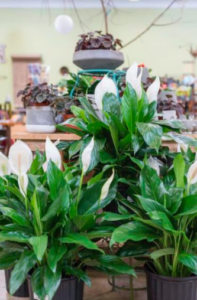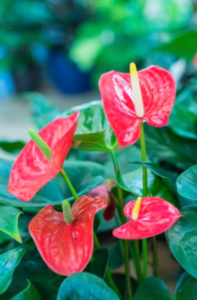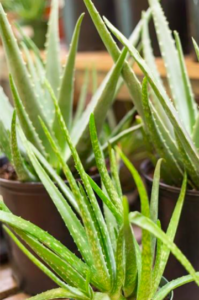-Kristen Weeks-
The benefits of adding houseplants to your home decor go far beyond aesthetics. Research shows that being among greenery reduces stress and creates a more tranquil and relaxed environment. It is no wonder that spikes in productivity have also been shown to occur in spaces with plants. There is also a general consensus among scientists that plants have the ability improve indoor air quality and reduce levels of certain types pollutants found in our homes and offices. Therefore, common houseplants are our allies in fighting indoor air pollution.

What are these pollutants and where do they come from?
The pollutants that affect health get trapped indoors when there’s poor (or no) ventilation, and are released from many sources such as new furniture, carpet, building materials, cleaning products, paints, and cosmetics. These pollutants include formaldehyde (from insulation, furniture, flooring), trichlorethylene (VOC’s, degreasers, adhesives), and xylene (rubber, printer ink, cleaning products). We aren’t talking about allergens such as pollen, dust, or pet dander, which are bothersome but aren’t considered airborne chemicals that will be taken up by houseplants.
How do plants clear the air?
Plants are able to absorb toxic particulates through their leaves (and roots) at the same time they take in carbon dioxide (CO2) during the process of photosynthesis. The CO2 is then converted into oxygen and released back into the air, which is also purifying. Much of what we now know about which plants best mitigate certain chemicals comes from a 1989 NASA study where researchers were trying to find ways to improve air quality in the space station. Results of the 2-year study showed that plants were effective air cleaners.
So, which plants are the best air cleaners?
Dr. B.C. Wolverton, an environmental engineer from Washington, was the research scientist behind the NASA study, and much of his research is summarized in his book, How to Grow Fresh Air – 50 Houseplants that Purify Your Home or Office. He assigned plants a rating from one to 10, based on their ability to remove chemical vapors or indoor air toxins and their subsequent resilience. The top 10 on that list include:
- Areca palm – 8.5, all indoor air toxins
- Lady palm – 8.5, all indoor air toxins.
- Bamboo palm – 8.4, benzene, trichloroethylene and formaldehyde
- Rubber plant – 8.0, formaldehyde.
- Dracaena “Janet Craig” – 7.8, all indoor air toxins, especially cigarette smoke
- English ivy – 7.8, formaldehyde
- Dwarf date palm – 7.8, xylene
- Weeping Fig– 7.7, all indoor air toxins
- Boston fern – 7.5, formaldehyde
- Peace lily – 7.5, alcohols, acetone, trichloroethylene, benzene and formaldehyde
Other (easy-to-care-for) air cleaning houseplants include:
- Spider Plant – formaldehyde, xylene
- Pothos – formaldehyde
- Sansevieria (Mother-in-Law’s Tongue | Snake Plant) – benzene, formaldehyde, trichlorethylene, and xylene
- Aloe Vera – VOC’s, benzene
- Bromeliad – VOC’s
What else is there to know about air-cleaning plants?
The type of soil, lighting, and size of the plant can all affect the plant’s ability to absorb pollutants and clean the air. Lighting is critical because you have to have enough light for photosynthesis to occur, and without photosynthesis, the plant can’t take in CO2 along with the pollutants. So, proper lighting and care is important. The bigger and leafier the plant, the more cleaning it can do.
To keep plants healthiest and at their most efficient in cleaning the air, you’ll also want to refrain from using chemical fertilizers and pesticides, and be sure to only choose a high-quality organic soil. That’s because microorganisms found in the soil are also helpful with the cleaning process. Overwatering your plants is another thing to look out for, as overwatering can lead to mold, and you don’t want that when trying to detoxify! Lasly, deck out your space with as many plants as you can. It is recommended that you have two good-sized plants (8” and larger) per 100 square feet of living space (or approximately 15-18 per 1800 square foot home).
In general, folks are becoming more aware of how environmental toxins impact health and are seeking out ways to combat them naturally. Of course, eliminating toxic cleaners, cosmetics, and other off-gassing materials from your home is a good place to start. We don’t live in space stations but we do spend a great deal of time indoors, which can be more toxic than outdoor pollutants. This is where we can turn to our plant allies for help!





RYAN SHEA says
This is in fact not backed by science. More is cleaned by a simple central air filter.
https://drexel.edu/now/archive/2019/November/potted-plants-do-not-improve-air-quality/
Deborah Heroman says
Plants do clean air and is backed by years of research. The media coming out now that says they do not is sponsored by air filter companies.
Neeraj mall says
Plant is successful in European countries because in theses countries weather is suitable in side the house,but in Asian countries to hot inside and plants are not growing successful so they could not help to purify the house,but they grow outside the house and keep the environment clean, it is true that plant help us cleaning our environment.